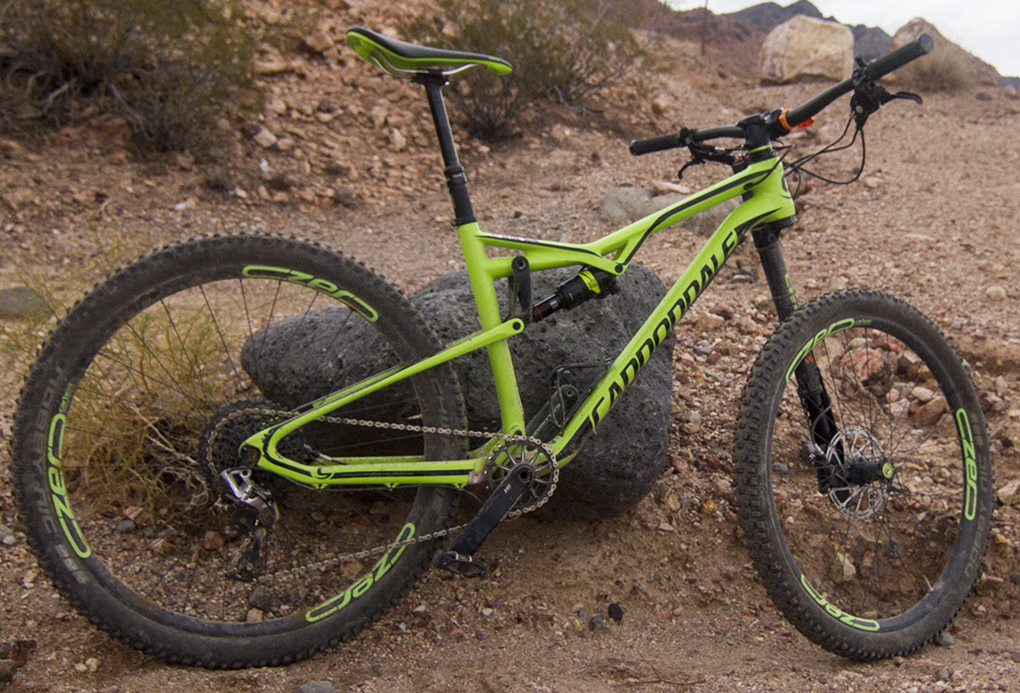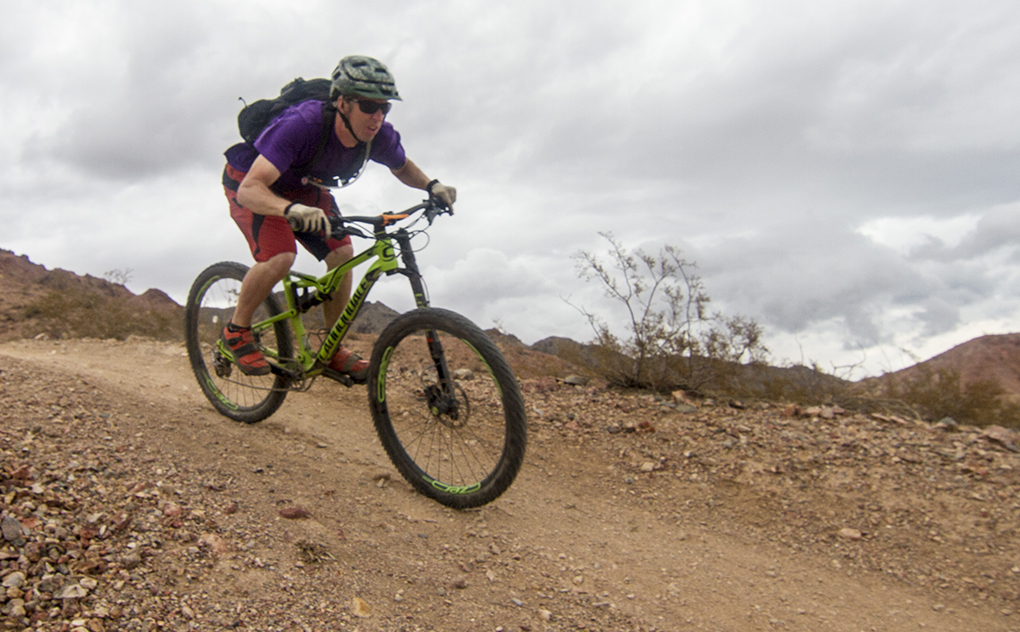Bike: Cannondale Habit Carbon 1
Size Tested: Medium
Geometry: (Here)
Build Overview:
- Drivetrain: SRAM X01 / XX1
- Brakes: SRAM Guide RSC
- Fork: Lefty 2.0 Carbon
Wheels: 27.5′′
Travel: 120 / 120 mm
Blister’s Measured Weight: 24.7 lbs (11.2kg) without pedals
MSRP: $7,460
Reviewer: 5’9”, 155 lbs.
Test Location: Boulder City, Nevada

Caveat
Interbike’s outdoor demo is located at Bootleg Canyon in Boulder City, Nevada. It’s a fantastic network of trails, and it’s a great escape from America’s neon bunghole (Las Vegas). The trails we spent most of our time on were relatively fast, with a fair amount of sand and some pretty rocky sections.
Riding bikes at a demo is always kind of tricky. For starters, we’re unable to get as much time on each bike as we like–our test durations are measured in minutes and hours, not our preferred time frame of weeks and months. One good ride can tell you a lot about how a bike handles, but it certainly doesn’t allow for the customary, in-depth, Blister analysis.
Demo days also don’t generally permit the time needed to get each bike dialed to our liking. A quick suspension setup and fiddling with the bike’s ergonomics gets it most of the way there, but it’s certainly not dialed. We also take the bike as we get it, so things like bar width and tire selection may not be optimal.
So while we believe it’s important to be upfront about the limitations of reviewing bikes in such settings, there is also merit in riding a slew of bikes, back to back, on the same trails. Subtle differences that might not become apparent if our test rides happen weeks or months apart are able to come to light, and each bike’s attributes may be more easily identified.
With all that in mind, let’s take a look at the Cannondale Habit Carbon 1
Cannondale Habit Carbon 1
The Habit is Cannondale’s latest addition to its lineup, and it fills the shorter-travel trail bike niche. With 120mm of travel, it’s a notch below the the 140mm Trigger, but it’s still intended to be a relatively aggressive bike (at least according the Cannondale’s marketing department).
The Habit is running on 27.5” wheels, which, along with its travel, pit it against bikes like the Santa Cruz 5010 and the Scott Genius 700.

The Build
The core of the Habit 1’s componentry is a mix of high-end SRAM shifty bits and Shimano stoppers. As expected, these all worked flawlessly. No complaints there.
But any discussion of the build on a Cannondale, at least in my mind, really comes down to how much proprietary crap Cannondale has hung on the frame. Now before Cannondale apologists get all up in arms, most of the Cannondale parts are actually pretty nice, and Cannondale has a history of innovation that, at least in a few cases, has caught on throughout the bike industry.
But proprietary parts are often expensive and difficult to replace, and there are plenty of frames out there (Cannondale and otherwise) that have been rendered worthless simply because some weird proprietary part on them is no longer available.
In that regard, it’s welcome to see that the Habit sports a normal Rockshox Debonair rear shock (albeit one with a remote lockout), rather than the DYAD shock found on the Trigger and Jeckyll.
Similarly, the crankset, while a Cannondale-branded part, still uses a BB30 system that’s relatively common these days.
And then there’s the Lefty fork, a topic of much internet debate. Yes, it’s proprietary. Yes, there are lots of stories of Lefties ceasing to function properly. Yes, they’re really expensive to replace.
Putting that aside for the moment, does it actually work?
More or less, yes. A common concern is stiffness, but that’s not an issue here. I’d say the Lefty is actually stiffer than most comparable forks.
Its suspension action is also quite good—it’s very smooth and supple, and it irons out the trail nicely.
Where it falls short is (1) It’s not really adjustable at all. The only external adjustment is the rebound speed. (2) It blows through its travel. Even raising the air pressure to a point where I was running relatively little sag, I was still bottoming it out pretty easily.
The Fit
In terms of fit, the Habit definitely gets on board with modern trends of longer front ends and shorter rear ends. The Medium that I rode has a 427mm (16.8”) reach, which is at the long end of things. Cannondale also doesn’t spec a particularly short stem on the Habit, so the bike feels fairly stretched out.
At the rear end, the Habit has 429mm (16.9”) chainstays, which would have been considered short a few years ago, but these days are more or less average. And generally speaking, I think that’s a good thing; they’re short enough that you can still loft the front end of the bike without getting a hernia, but they’re long enough to lend a bit of stability.
The rest of the Habit’s numbers point to a bike that’s intended to be moderately aggressive, while still retaining the ability to tackle long climbs. A low-ish bottom bracket (334mm / 13.1”) coupled with a moderate 68° head tube angle keeps things fairly planted, although it’s certainly not as low or slack as the more extreme examples in this class. It also has a moderately steep 74° seat tube angle, which helps keep weight forward and the front end planted on climbs.
NEXT: The Ride, Etc.
